GP- Article
India and the 2036 Olympics: Dream or destiny?
An analysis of India’s bid, athlete development, and policies for the future.

The Sardar Vallabhbhai Patel Sports Enclave in Motera is the centerpiece of India's 2036 Summer Olympics ambitions. (Photo credit: Populous)
India has long nurtured Olympic dreams, but turning those aspirations into reality remains a complex challenge.
Owing to a history of limited success at the Olympics, India’s national mood about the flagship quadrennial event is cautiously optimistic. That said, recent success has hinted at a change. Neeraj Chopra’s javelin gold in Tokyo 2020 and PV Sindhu’s medals in badminton, for instance, have broken decades of dormancy.
On the other hand, experts and the International Olympic Committee (IOC) note that India’s overall medal count is still meagre for a nation of 1.4 billion. Hosting the 2036 Summer Olympics is now on India’s agenda, with Ahmedabad, Gujarat chosen as the candidate city.
But is this vision a realistic destiny or a far-off dream for the country?
A legacy of hopes and challenges
India does have a storied Olympic history. The country won eight Olympic hockey golds between 1928–1980. However, since hockey’s decline, India managed just two golds in three decades: Abhinav Bindra’s shooting gold in Beijing 2008 and Chopra’s javelin triumph in Tokyo 2020.
The Tokyo Games were India’s best-ever performance with seven medals, and Paris 2024 yielded another six, including Chopra’s silver. Even with these gains, India - with a contingent of 110 athletes - ranked 71st in Paris.
India’s total Olympic medal tally now stands at 41.
Veterans note that coming close – with several fourth-place finishes – shows potential, but converting near-misses into medals requires scale and sustained investment.
India’s Olympic journey also has political and social dimensions. The 2010 Commonwealth Games in New Delhi proved India can host major international events, but also exposed issues like cost overruns and corruption, underscoring the importance of transparency and execution.
Athletic ambitions and policy push
The government has formal plans to strengthen India’s sports ecosystem. In July 2025, the Union Cabinet approved the National Sports Policy 2025 (branded Khelo Bharat Niti) with an audacious goal: to make India a top-five sporting nation by 2047.
The policy explicitly mentions the 2036 Olympics, aiming to create a talent pipeline “from grassroots to the Olympic podium.” Key pillars include improving rural and urban infrastructure, boosting sports science, reforming federations through regulatory oversight, and using sport as a development engine.
Initiatives like Khelo India youth games and grassroots talent scouting programs are already identifying and nurturing young athletes. The Sports Authority of India is expanding training centers and support for elite athletes. States are pitching in too: Telangana has volunteered to co-host certain events and requested central funding to boost facilities. A bid for the 2030 Commonwealth Games is also on the table and is viewed as a possible rehearsal for the Olympics.
India’s recent athlete performances, meanwhile, have energized its Olympic ambitions.
Two-time medalist Neeraj Chopra - gold in Tokyo 2020, silver in Paris 2024 - has become a national icon, and continues to set new standards in athletics. PV Sindhu’s consistent success in badminton, alongside medals from weightlifter Mirabai Chanu and wrestler Ravi Kumar Dahiya, reflect growing elite-level competitiveness. A rising generation of shooters are also making its mark internationally.
Breakthroughs in non-traditional sports are equally promising. India’s women’s table tennis team pulled off surprise wins against higher-ranked countries in Paris, suggesting real depth beyond legacy sports like hockey and wrestling.
To explore more opportunities in various other sports click here.
Still, former Olympians like Dipa Karmakar warn of a structural flaw: many Indian athletes receive serious support only just before the games, unlike global peers who train year-round in well-funded, science-backed systems. This inconsistency hampers performance.
The Khelo Bharat Niti aims to fix this through continuous funding, athlete pathways, and sports science integration. But unless execution matches intent, India risks getting caught in moments of brilliance instead of building sustained Olympic momentum.
The 2036 bid: Ahmedabad and IOC dialogue
India has officially entered the IOC’s “Continuous Dialogue” phase for future host nations. In 2025, a high-level Indian delegation confirmed Ahmedabad as the candidate city. Their pitch emphasized youth inclusion, urban development, and innovation.
The IOC, however, has offered candid feedback: India must address sports governance issues, doping records, and underwhelming Olympic performance before moving further.
Meanwhile, Ahmedabad’s infrastructure plan is ambitious. The Gujarat government has budgeted ₹22,878 crore (~$2.7 billion) for developing sports facilities. The Sardar Vallabhbhai Patel Sports Enclave in Motera, including the world’s largest cricket stadium, will be the centerpiece. The Karai Complex in Gandhinagar will add a new athletics stadium, indoor arenas, and a shooting center. Master planning is underway by top global consultants, ensuring that India is aligning with international standards.
Although Ahmedabad is the official bid city, other states like Telangana and Delhi have expressed interest in hosting select events. India’s experience in multi-city hosting from the Commonwealth Games suggests this model could work, though it presents logistical and coordination challenges.
Hurdles and home truths
Despite momentum, several challenges remain.
Governance and reform are critical. Sports federations in India have often suffered from political interference and poor transparency. The new sports policy proposes a regulatory body to address this, but actual implementation will determine success.
India must also widen its athletic base. For a country of 1.4 billion, the Olympic delegation remains small. Experts believe that if India can triple the number of participating athletes, medal counts will follow. But this requires training access, funding, and grassroots engagement, especially in underrepresented regions.
Financial sustainability is another question. With massive spending required to host the Games, the return on investment – both in terms of legacy and public benefit – must be carefully planned. India's sports funding still pales in comparison to its cricket ecosystem, and systemic change is needed to balance that disparity.
Lastly, the global bidding landscape remains competitive. Countries like Saudi Arabia, Germany, and Indonesia are also in contention. And given that the IOC’s selection process has evolved, India's bid must showcase not just infrastructure but also organizational credibility, inclusivity, and legacy value.
Eleven years is a long time in sports. India’s quest for the 2036 Olympics is both ambitious and pragmatic. As the world’s fifth-largest economy with a youthful population and growing sports culture, India has a strong foundation. With robust policies like Khelo Bharat Niti, infrastructure development, and rising athlete performances, the vision for 2036 feels within reach.
Yet, dreams must be backed by discipline. Clean governance, broader talent inclusion, and a consistent investment pipeline are non-negotiable. The coming years will be a test of India’s resolve-not just to host the games, but also to shine in them.
Whether 2036 becomes India’s Olympic destiny or it remains an unfulfilled dream depends on what happens now. The road to the games has begun and it is paved with both potential and responsibility.

